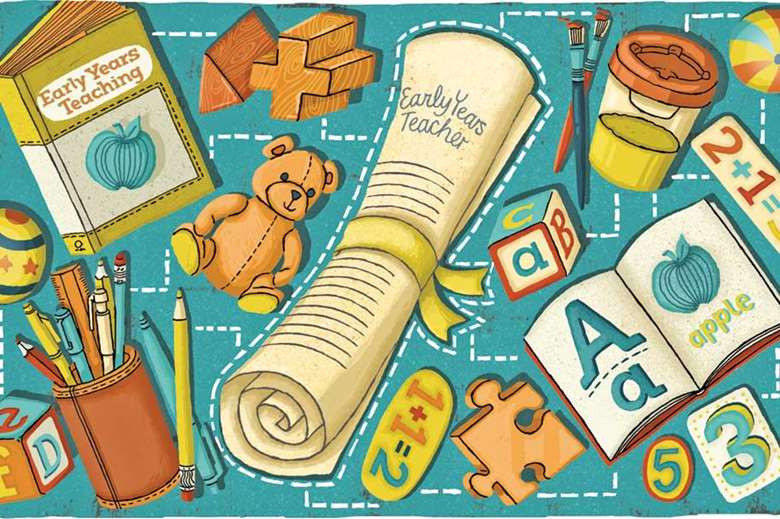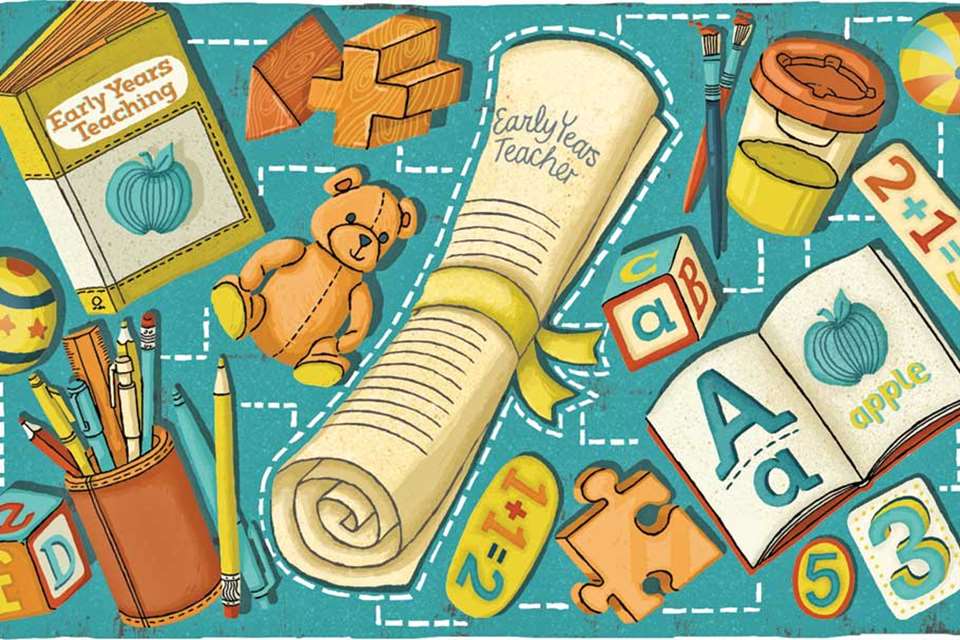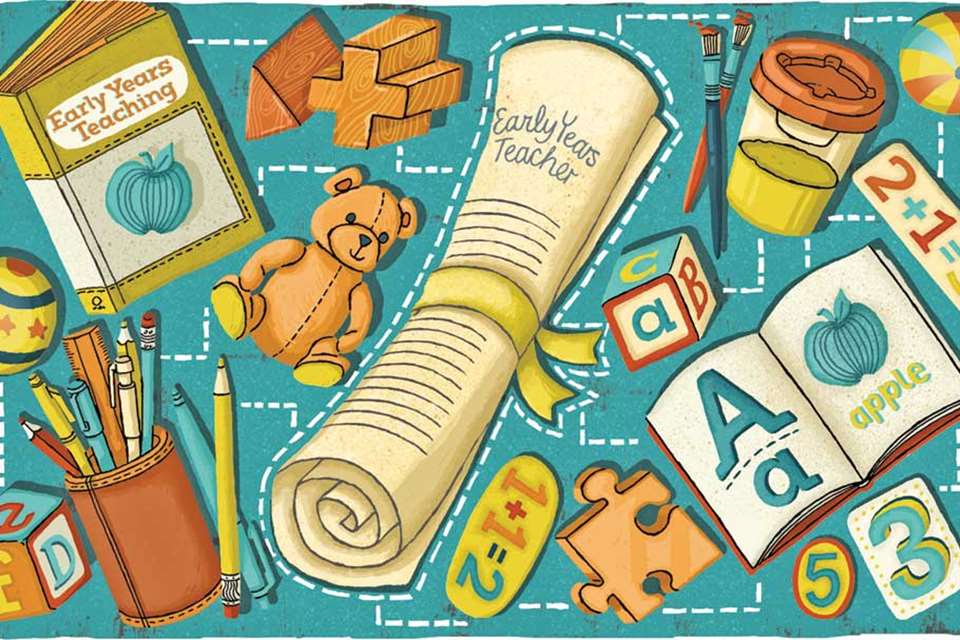Early Years Teacher, Standard 3 - Taking the longer view
Karen Faux
Monday, December 2, 2013
Standard 3 is all about understanding the continuum of learning, from the EYFS through to Key Stages 1 and 2, says Karen Hart.

Standard 3
An Early Years Teacher must:
3. Demonstrate good knowledge of early learning and Early Years Foundation Stage (EYFS)
In addition to knowledge and understanding of the EYFS, practitioners should consider ways of observing and planning for children's successful learning and development. They will need to identify areas of particular interest for individuals, tailor activities specifically towards these areas of interest, observe children at play, and record progress made in each area of learning and development.
SUPPORTING STATEMENTS
3.1 Have a secure knowledge of early childhood development and how that leads to successful learning and development at school
When working towards covering this section of the standard, remember to demonstrate an understanding of the needs and individual requirements of all children in your care.
Young children differ greatly in their range of abilities and can progress enormously in a short space of time. Aim to show an understanding of the importance of catering for the needs of individuals throughout your planning and assessment - picking up on a child's particular interests, abilities and areas to build on - and plan activities that can be easily adapted to suit all children in a group setting.
Denise Reardon, programme director for Faculty of Education at Canterbury Christ Church University, offers the following suggestions for specific areas to concentrate on in relation to meeting the criteria:
- Your knowledge and understanding about the stages of learning and development that children (0-5 years) experience in the EYFS.
- Your knowledge and understanding about the expectations for children's learning and development once they enter National Curriculum Key Stage 1 and Key Stage 2.
- Your knowledge and understanding about the level of learning and development that is expected of children as they make the transition from the EYFS into the National Curriculum Key Stages 1 and 2.
3.2 Demonstrate a clear understanding of how to widen children's experience and raise their expectations
Look at ways to share the personal experiences of children in your care with others in your group. Also, this is an opportunity to bring the wider community into your setting by looking for ways to share experiences such as craft skills, cooking sessions, cultural storytelling, song and dance.
What to identify
To show how you plan challenging and enjoyable experiences for all children across all areas of learning and development in the EYFS, try to identify examples of your own personal practice to demonstrate how you encourage and support them to learn and develop in a way that is appropriate to their:
- individual needs, interests and stages of development
- special educational needs that sometimes need specialist input or support
- religious, cultural or language circumstances calling for specialist input and/or support.
3.3 Demonstrate a critical understanding of the EYFS areas of learning and development and engage with the educational continuum of expectations, curricula and teaching of Key Stage 1 and 2
When building an understanding of the EYFS areas of learning and development, remember to include the transition periods between foundation stage and Key Stages 1 and 2, building activities/learning opportunities to help children progress through these stages.
Similar to Standard 2 (2.2) and Standard 3 (3.1), you may wish to reflect on ways to illustrate the following:
- Your understanding about the way the EYFS areas of learning and development continue in National Curriculum Key Stage 1 and Key Stage 2.
- How you use your critical understanding of the EYFS areas of learning and development to prepare children for the expectations of the National Curriculum Key Stage 1.
- Examples of the way that you have empowered children to make a smooth transition from EYFS to Key Stage 1.
3.4 Demonstrate a clear understanding of systematic synthetic phonics in the teaching of early reading
To cover this area of the standard, when working with most children in this age range aim for a general awareness of the formation of sounds and how these build words by the use of adult-led pre-reading games and activities - for example, focusing on sound blends during story reading sessions, and a recognition of the relationship between letters and sounds. Do not be tempted to push the learning; keep it at the individual child's pace.
Things to think about
- How you have personally developed a critical understanding about high-quality phonic resources - for example, using the DFE criteria for assuring high-quality phonic work (2012), the Rose Report (DfE 2006, DCSF 2009) and associated literature.
- Your understanding that for most children, high-quality, systematic phonic work should start by the age of five and should be preceded by pre-reading activities that pave the way for such work to start.
- How you use your principled, professional judgement based on structured observations and assessments to introduce developmentally appropriate systematic phonic work - for example, syllables, rhyming chunks and phonemes.
- How you organise a literature-rich language environment that takes full account of developing the four interdependent strands of early language development: speaking, listening, reading and writing and increasing children's vocabulary.
- How you develop children's (0-5 years) love of books, early reading, mark making and early writing skills to prepare them for later stages of systematic synthetic phonics, reading and writing in the National Curriculum Key Stage 1 and 2.
- How you facilitate early phonic work that is multi-sensory and captures children's imagination, for example, through music, rhythm, rhyme and song, together with stories and poetry.
- How you monitor arrangements to assure the quality and consistency of early phonic work, and, that staff receive constructive feedback about their practice as well as appropriate training and professional development.
- Work in partnership with parents to share systematic synthetic phonics resources and story books with language and bedtime reading ideas for parents to use with their children at home, maybe with supporting guidance and appropriate vocabulary.
3.5 Demonstrate a clear understanding of appropriate strategies in teaching of early mathematics
Mathematics runs through every aspect of everyday life, so you can think of some fun ways to incorporate maths into lots of activities - cooking, outdoor nature treasure hunts, simple jigsaw puzzle making or creating pictures with collage shapes. Even fitting play bricks back in their box is good for reinforcing ideas about shape and size.
As a trainee Early Years Teacher, you may wish to consider the wide range of strategies available for you to teach mathematics. Here are some options:
- Use daily routines to develop mathematical concepts - this could be tidying up, preparing snacks, dishing out portion sizes, pouring drinks, finding matching shoes and wellies, or asking children to find a partner.
- Use stories to talk about size and positional language. Examples are The Three Bears - small, medium and large - or Michael Rosen's We're Going on a Bear Hunt - 'We can't go over it, we can't go under it'.
- Use mathematical language and numbers during your daily activities - counting places, plates and cutlery, the number of children, the time, or using positional language to count steps, hops, jumps, skips, distance, direction and position.
- Use songs and rhymes, such as Incy Wincy Spider, One, Two Buckle My Shoe and Five Little Speckled Frogs.
- Use small-world block play and activities to develop problem-solving skills.
- Use junk-modelling items such as recycled cardboard packaging, boxes and pieces of material for children to make mathematical artefacts and props with.
- Encourage children to make shapes and patterns using different coloured play dough and craft paper and encourage children to draw shapes in paint, mixed media, sand or mud kitchens
- Scaffold children’s mathematical language and learning by engaging discussion during child-initiated play. For example talk about ordering and grouping man-made and natural materials, describe shape, space, measures and patterns, inside and outside of the setting
- Encourage positional language during practical activities for example in front, behind, forwards and backwards using remote controlled cars or robots
- Set up displays and interest tables to encourage children to explore numbers and shapes
- Set up the role-play area (e.g. a doctors surgery, café, fire station or hairdresser ) to offer everyday mathematical opportunities
- Use small world play to build in three dimensions and problem solve, for example; building a bridge for the Three Billy Goats Gruff
- Use sand and water play to explore volume; capacity; conservation of amount, comparison between quantities and estimates
- Provide opportunities for children to mark make numbers, count and understand place value, for example; lining up bricks, beads etc.
- Provide opportunities for children to visualise and use numbers, patterns, shapes, space and measures inside and outside the setting, go on environmental walks, such as the park, through woodland, along the high street, visits to shops to identify colour, shape, pattern and number
- Work in partnership with parents to share mathematical games and story books with mathematical ideas for parents to use with their children at home, maybe with supporting guidance notes on mathematical activities and appropriate vocabulary
- Monitor arrangements to assure the quality and consistency of mathematical activities and that staff receive constructive feedback about their practice as well as appropriate training and professional development.
- Work in partnership with parents to share mathematical resources and story books with numbers and mathematical concepts to use with their children at home, maybe with supporting guidance and appropriate mathematical vocabulary.
'DON'T BE DAUNTED'
Ms Reardon shares her thoughts on Standard 3
'Standard 3 is a whopper! It refers to the whole of the EYFS, and National Curriculum Key Stages 1 and 2. However, don't be daunted; the clue is in the words used. You are being asked to demonstrate a clear, critical and secure understanding about each of the phases that children pass through. Trainees undergoing assessment of this standard may very well be experts in one phase or another, but your assessor will need to feel confident that you have clear, critical and secure knowledge about what is expected throughout the continuum of learning that a child will pass through.
'On a personal level, I believe that this can only strengthen your understanding about the importance of getting it right in the early years and your commitment to giving all children the best start possible.
'There has been a lot of debate concerning developmentally appropriate systematic synthetic phonics in the teaching of early reading. I believe that 3.4 needs to be approached very cautiously. For most children, high-quality systematic phonic work should start by the age of five and be preceded by pre-reading activities. Your role in the grand scheme of systematic synthetic phonics is to capture children's interest and love of language, books, letters and sounds as creatively and as imaginatively as possible within a language-rich environment.
'Mathematical learning and development in the EYFS is fun, and like early language learning there are endless opportunities for babies, toddlers and young children to engage in stories, rhymes, activities, numbers games, shapes, position and movement from the moment they are born and long before they enter Key Stage 1 and 2. It is your role to link cross-curricular activities and create a mathematically rich learning environment.'
Tamer Moore, Deputy Manager of Brightfields Pre-school, Peterborough, adds her thoughts on the criteria for learning in standard 3:
'As part of the Pre-School Learning Alliance, we advocate learning through play, and keep all learning both child-centred and wherever possible, focused on each individual child’s areas of interest. Children’s needs and abilities vary so much during early years, with some children being reading-ready while others will still be at the dummies and nappies stage. Some of the activities we use at Brightfield’s which cover the areas of learning as stated in standard 3 are:
- Rhyming strings; little adult-modelled, improved rhymes such as: ‘Fred went to bed and bumped his head’, or ‘the green bean queen’, which children can join in with and have a guess at which word come next
- Clapping out the syllables in our names and the words in songs
- Encouraging mark making
- Story telling sessions with adults starting a story and children joining in
- Games and equipment available for children to use as they wish include: calculators, playing cards, dominoes, board games with dice, number matching games and calculating games such as, how many bricks to take away to make the rest will fit in a box
- And always, as much conversation as possible – benefitting all areas of the curriculum
More information
Part 5 of this series in Nursery World on 13 January will look at Standard 4.






